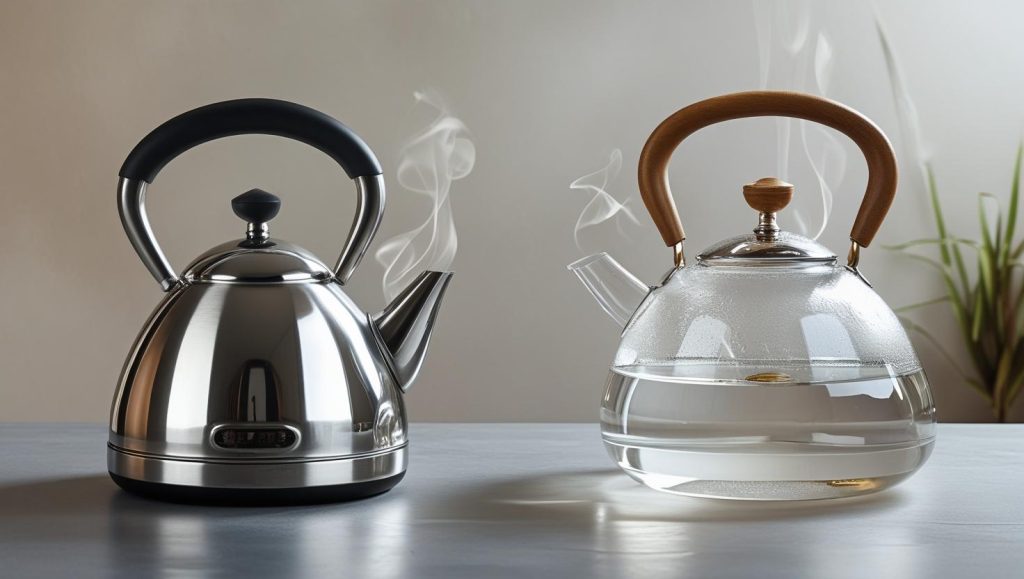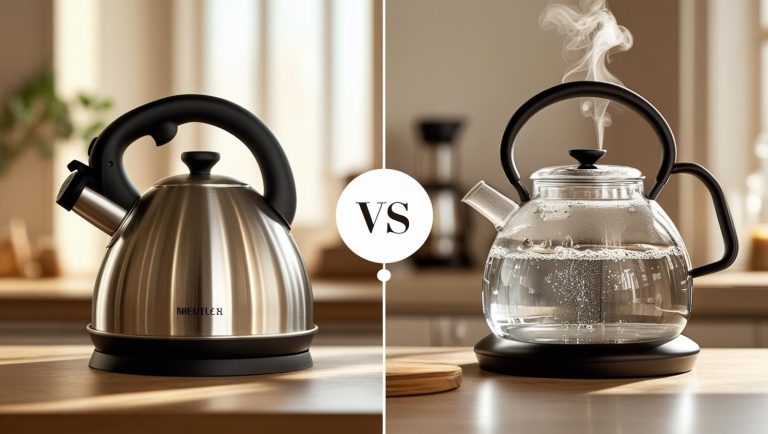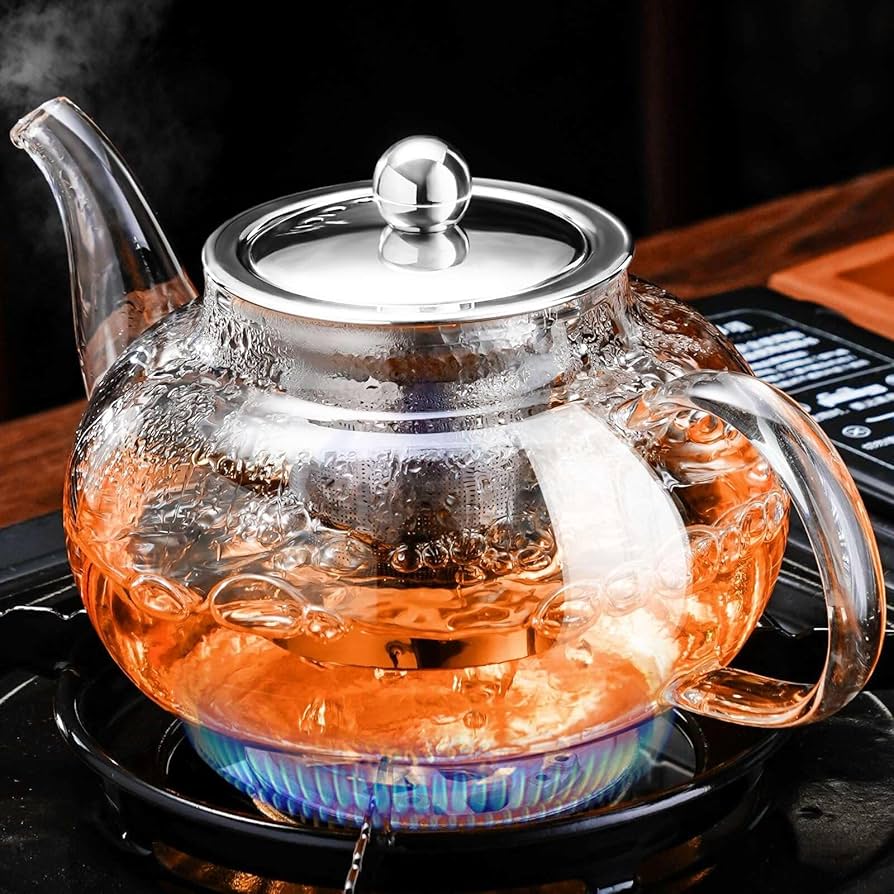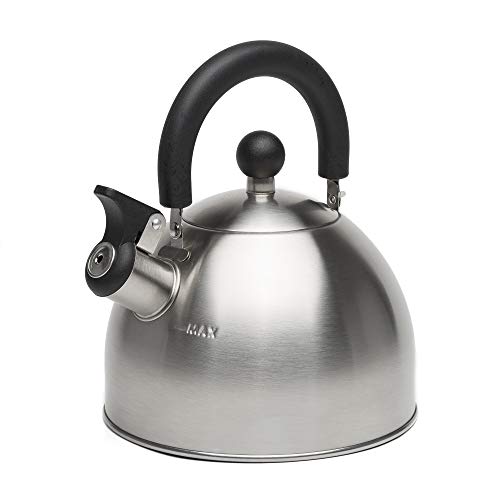Picture this: it’s a cozy morning, and I’m preparing to brew my favorite tea. I reach for my kettle, but then I pause… Should I grab my stainless steel kettle or the sleek glass one sitting nearby? This is a question that’s probably crossed your mind too, right?
Choosing the right kettle isn’t just about boiling water. It’s about making your tea-making routine feel extra special, just the way you like it. Both stainless steel and glass kettles have their perks, and depending on your personal style and needs, one may be a better fit for your kitchen than the other. Let’s walk through the pros and cons of each to help you decide which one is perfect for your tea time.
Material Benefits
When choosing a tea kettle, the material it’s made from plays a big role. Here’s a breakdown of how stainless steel and glass kettles compare.
Durability and Longevity
I’ll be honest – I’m all about items that last. Stainless steel kettles are tough! They’re resistant to dents and scratches, which means they’ll stick around for years. Glass kettles, though stunning to look at, are a bit more fragile. They’re made from heat-resistant borosilicate glass, so while they’re strong against heat, they might not stand up as well to daily bumps and drops.
Aesthetic Appeal
If you’ve ever admired the beauty of a glass kettle, I totally get it. There’s something so mesmerizing about watching water bubble and boil in one. Plus, glass kettles add an elegant touch to your kitchen. Stainless steel kettles, on the other hand, have a sleek, modern look. They’re shiny and fit perfectly into almost any kitchen style. Both materials bring something special to your countertop – it really depends on whether you want function or a bit of visual magic.
Heating Efficiency
Let’s be real – we all want our water to boil fast so we can get on with our tea routine. Here’s how these two materials perform.
Boiling Speed
Stainless steel is a speedster when it comes to boiling water. The metal conducts heat quickly, which means your water heats up in no time. Glass kettles take a little longer because glass doesn’t conduct heat as well. So, if you’re rushing to make tea, stainless steel will probably get you there faster.
Energy Consumption
I’m always trying to save a little on my energy bill, and I’ve found that stainless steel kettles tend to be more energy-efficient. Since they heat up quicker, they use less energy to boil your water. Glass kettles, on the other hand, use more energy because of their slower heating time. So, if saving energy is a priority, stainless steel might be the better choice.
Safety Considerations
In my kitchen, safety always comes first. Here’s a quick rundown of the safety features of both types of kettles.
Chemical Leaching
When it comes to safety, I trust stainless steel because it’s made from non-reactive materials. That means it won’t leach chemicals into your water, making it a safe choice for boiling. Glass kettles are also a great option. They’re made from non-toxic, heat-resistant glass, which means no harmful chemicals will alter the taste of your water. Both are safe choices, but glass does have a slight advantage in terms of purity.
Temperature Resistance
I love that stainless steel can handle extreme heat. It’s durable and will withstand high temperatures without issue. Glass kettles, while strong, require a little extra care. They can crack if exposed to sudden temperature changes. So, if you’re like me and sometimes pour water straight from the tap, a stainless steel kettle might be the better fit for you.
Maintenance and Cleaning
No one likes a kettle that’s hard to clean, right? Here’s what you can expect when maintaining each type.
Ease of Cleaning
When it comes to cleaning, stainless steel kettles are super easy. A quick rinse and mild soap are usually all you need. I love how easy it is to maintain. Glass kettles are a bit trickier. The best part is that you can see any buildup of residue, so it’s easy to spot. But they can require a bit more elbow grease to keep them sparkling clean. I’ve found that a mix of vinegar and water works wonders for removing stains and residue. Just make sure you’re gentle with it!
Stain and Odor Resistance
Stainless steel doesn’t tend to absorb odors or stains, which is great if you love experimenting with different teas. Glass kettles, however, can sometimes hold onto the scent of stronger teas. I’ve noticed that a quick vinegar soak can get rid of any lingering smells. Regular cleaning is key to keeping your glass kettle looking and smelling fresh!
Cost and Value
Let’s talk about the price – because, let’s be honest, we all want to make the best choice without breaking the bank.
Price Range
In terms of price, stainless steel kettles usually fall in the mid to high range. They’re built to last, which makes them worth the investment. Glass kettles are generally more affordable, but they can vary depending on the design and brand. Even though glass is usually cheaper, their fragility may lead to higher replacement costs in the long run.
Long-Term Investment
I’ve found that investing in a stainless steel kettle is worth it. It’s durable and will last for years without showing signs of wear and tear. Glass kettles, while beautiful, might not stand the test of time quite as well. You might need to replace them sooner than you’d like. But if style is your top priority, glass still offers fantastic value.
Environmental Impact
As someone who’s conscious about the planet, I always consider how my choices affect the environment. Here’s what you should know about the environmental impact of both materials.
Sustainability
Stainless steel is a solid option for eco-friendly buyers. It’s durable and made from recycled materials, so it has a smaller environmental footprint. Glass kettles, while recyclable, can be less efficient to process. Plus, because they can break easily, you might find yourself replacing them more often. This could lead to more waste in landfills over time.
Recyclability
Both stainless steel and glass are recyclable, but stainless steel has the advantage here. It can be recycled multiple times without losing quality. Glass is recyclable, but the process can be a bit more complicated, especially with heat-resistant glass. If sustainability is something you care about, stainless steel is the clear winner.
User Experience
Lastly, let’s talk about the overall experience of using each type of kettle. Both materials have their perks!
Design and Functionality
Stainless steel kettles are sleek and modern. They’re perfect if you want something that looks great and functions efficiently. Glass kettles, though, have a unique appeal. The clear body lets you see the water boiling, which can be a calming and enjoyable experience. Both types offer something special, depending on whether you prefer function or aesthetics.
Noise Level
I’ve noticed that stainless steel kettles tend to be a bit louder when they’re boiling. The metal amplifies the sound, which can be a bit distracting. Glass kettles, on the other hand, are much quieter. If you love a peaceful tea-making moment, a glass kettle might be the way to go.

Real-Life Scenario: Which Kettle Fits Your Tea Routine?
Imagine it’s a typical morning in my home. I’ve got a few minutes before I need to head out, and my tea time is essential for a calm start to the day. If I’m in a rush, I reach for my stainless steel kettle because I know it’ll get the water boiling quickly. But, on weekends, when I’m enjoying a slow morning and maybe having a friend over, my glass kettle becomes my go-to. It looks beautiful on the countertop and adds a little extra charm to my tea experience.
Scenario Breakdown:
-
Quick Morning Tea: Stainless steel for its speed and efficiency.
-
Leisurely Weekend Tea Time: Glass for its elegance and visual appeal.
Preference Chart: Which Kettle Should You Go With?
| Preference | Go With |
|---|---|
| Need Quick Boil | Stainless Steel |
| Want an Elegant Look | Glass |
| Durability is a Priority | Stainless Steel |
| Looking for Purity & Safety | Glass |
| Eco-Conscious | Stainless Steel |
| Easy to Clean | Stainless Steel |
| Want a Visual Boiling Process | Glass |
| On a Budget | Glass |
Frequently Asked Questions
1. Which is better, a glass or stainless steel kettle?
It really depends on what you’re looking for! Glass kettles are gorgeous and let you watch your water boil, which adds a little magic to your tea time. They’re also free from metals, making them a great choice if you’re focused on purity. Stainless steel kettles, on the other hand, are more durable and heat up faster, making them perfect for those who want a reliable, quick boil. Both have their perks – it just comes down to what suits your style and needs!
2. Is it safe to boil water in a glass kettle?
Yes, absolutely! Glass kettles are made from high-quality, heat-resistant borosilicate glass, which is non-toxic and safe for boiling water. It won’t affect the taste of your water, and you don’t have to worry about any chemicals leaching into your tea. As long as you handle it carefully, glass kettles are a safe and stylish choice.
3. How do stainless steel kettles compare to glass in terms of durability?
Stainless steel kettles are built to last! They’re resistant to dents, scratches, and rust, making them incredibly durable, even with daily use. Glass kettles, while elegant, are more fragile. They’re prone to cracking or breaking if not handled gently, so if durability is your main concern, stainless steel is the way to go.
4. Are stainless steel kettles better for quick boiling?
Yes! Stainless steel kettles tend to boil water faster because they’re excellent at conducting heat. This makes them a great option for busy mornings when you need hot water in a hurry. Glass kettles, on the other hand, take a little longer to heat up due to the nature of glass. If you’re in a rush, stainless steel will save you time.
5. Can glass kettles be recycled?
Yes, glass kettles can be recycled, but the process can be a bit more complicated due to the special heat-resistant glass used. However, they’re still much better for the environment than plastic kettles. Stainless steel, on the other hand, is highly recyclable and can be reused multiple times without losing quality, making it a more sustainable option in the long run.
6. Do stainless steel kettles have any impact on the taste of my tea?
Nope! Stainless steel is non-reactive, which means it won’t alter the flavor of your water or tea. This makes it a great option for those who enjoy different types of teas without worrying about taste interference. Glass kettles are also great for taste since they don’t leach any flavors into the water either. So, you can enjoy your tea the way it’s meant to be!
7. How do I clean a glass kettle?
Cleaning a glass kettle is easy, but you’ll want to be gentle since the glass can be fragile. A vinegar-water mixture works wonders for removing any stains or residue. Regular cleaning will help maintain its transparency and keep your kettle looking fresh. Just be sure to handle it with care to avoid cracking or breaking.
8. Are there any chemical safety concerns with either material?
Not at all! Both stainless steel and glass kettles are safe for boiling water. Stainless steel is non-reactive, meaning it won’t leach chemicals into your water. Glass is made from non-toxic, heat-resistant materials, so you don’t need to worry about any harmful substances. Both are excellent, safe choices for your kitchen.
Conclusions:
Both stainless steel and glass tea kettles have something special to offer. Stainless steel is the go-to choice for durability and quick boiling, while glass is perfect if you love a stylish, elegant kitchen experience. Think about what matters most to you—whether it’s speed, style, or ease of cleaning—and pick the kettle that fits your needs. No matter which one you choose, you’ll be enjoying your perfect cup of tea in no time!
References:
- Choosing the Perfect Fit For Your Kitchen: Glass Kettle vs. Stainless Steel Kettle, https://www.crompton.co.in/blogs/kitchen-appliances-guide/choosing-the-perfect-fit-for-your-kitchen-glass-kettle-vs-stainless-steel-kettle
- How To Choose Between Glass Vs Stainless Steel Electric Kettles, https://www.ndtvshopping.com/appliances/glass-vs-stainless-steel-electric-kettles-for-your-household-8624255
- BENEFITS TO USING GLASS KETTLES, https://cafe-brew.com/benefits-to-using-glass-kettles/
- Exploring Thermal Conductivity in Stainless Steel, https://www.unifiedalloys.com/blog/thermal-conductivity-stainless-steel
- Exploring the Science Behind Rapid Boiling in Electric Kettles, https://ascot-home.com/blogs/news/exploring-the-science-behind-rapid-boiling-in-electric-kettles
- Which is more energy efficient – boiling water using an electric kettle, a kettle on a gas hob or a microwave oven?, https://www.theguardian.com/notesandqueries/query/0,5753,-2452,00.html
- Safest Non Toxic Cookware, Best Pots and Pans for Home Health, https://www.dustpanandbrush.com.au/post/safest-non-toxic-cookware-pots-and-pans-for-the-home
- Can I use stainless steel at high temperatures ?, https://bssa.org.uk/bssa_articles/can-i-use-stainless-steel-at-high-temperatures-2
- How to clean stainless steel appliances. https://www.nytimes.com/wirecutter/guides/how-to-clean-stainless-steel-appliances/
- We Tested the Best Electric Kettles for Hot Water in a Flash, https://www.thespruceeats.com/best-electric-kettles-4067665
- Why glass kettles shatter and how to prevent it, https://www.which.co.uk/news/article/why-glass-kettles-shatter-and-how-to-prevent-it-aRjZ02W7NgiM
- The Environmental Benefits of Stainless Steel, https://www.unifiedalloys.com/blog/stainless-environmental-benefits
- What are the Safest Materials for Tea Kettles & Tea Pots? https://www.healthierhomes.com/post/safest-material-for-tea-kettles,





